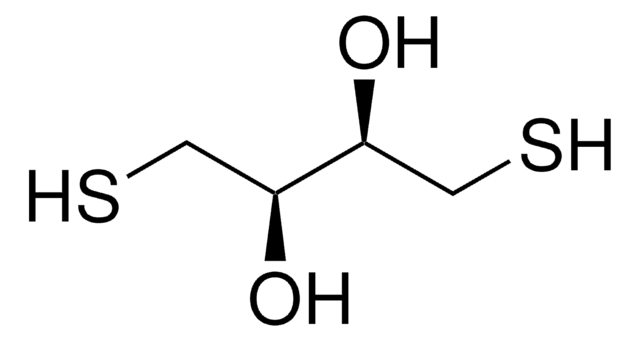646563
DL-Dithiothreitol solution
1 M in H2O
Synonym(s):
(±)-threo-1,4-Dimercapto-2,3-butanediol solution, DTT
About This Item
Recommended Products
form
liquid
Quality Level
reaction suitability
reagent type: reductant
concentration
1 M in H2O
density
1.04 g/mL at 20 °C
1.035 g/mL at 25 °C
SMILES string
O[C@H](CS)[C@H](O)CS
InChI
1S/C4H10O2S2/c5-3(1-7)4(6)2-8/h3-8H,1-2H2/t3-,4-/m1/s1
InChI key
VHJLVAABSRFDPM-QWWZWVQMSA-N
Looking for similar products? Visit Product Comparison Guide
Related Categories
General description
Application
- in western blot analysis
- as a supplement in lysis buffer to study its effects on sperm lysis
- as a component of cold homogenization buffer, and chilled wash buffer for the isolation of nuclei from frozen rat tissues
- in sodium dodecyl sulfate-polyacrylamide gel electrophoresis (SDS-PAGE), chromatography, modification of cysteine-containing compounds
Features and Benefits
Signal Word
Danger
Hazard Statements
Precautionary Statements
Hazard Classifications
Eye Dam. 1 - Skin Irrit. 2
Storage Class Code
12 - Non Combustible Liquids
WGK
WGK 2
Flash Point(F)
Not applicable
Flash Point(C)
Not applicable
Personal Protective Equipment
Certificates of Analysis (COA)
Search for Certificates of Analysis (COA) by entering the products Lot/Batch Number. Lot and Batch Numbers can be found on a product’s label following the words ‘Lot’ or ‘Batch’.
Already Own This Product?
Find documentation for the products that you have recently purchased in the Document Library.
Customers Also Viewed
Our team of scientists has experience in all areas of research including Life Science, Material Science, Chemical Synthesis, Chromatography, Analytical and many others.
Contact Technical Service




